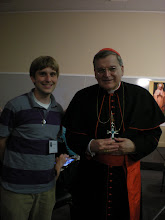Below is the summary for the second cycle of John Paul II's catechesis on the theology of the body. With minor editing, it came out to be 460 words. I earned an A-, however my professor told me to enhance the section on concupiscence, which I have done below, even more so than I had during my revisions before submitting the summary for grading. Now that we've discussed this cycle in class, I imagine the summary that follows would be top notch.
John Paul II looks to Christ's words in the Sermon on the Mount in order to execute the second cycle of audiences. He hones in on the specific verses, "You have heard it said, 'You shall not commit adultery.' But I say to you: Whoever looks at a woman to desire her has already committed adultery with her in his heart" (Mt 5:27-28). These words, for John Paul II, yet again call us back to "the beginning" as we saw in the first cycle. Once again, he exegizes the text of Genesis to set forth God's original plan for man's sexuality, marriage, and family.
Yet, John Paul II explains that, because of original sin, we now must speak of historical man, who is precisely not only Christ's immediate audience at the Sermon on the Mount, but also every single person to walk the earth since the Fall. John Paul II continues the second section of audiences describing in theological detail the effects of original sin on historical man. These effects are contained in the notion 'concupiscence', which is threefold--that of the flesh, that of the eye, and the pride of life--according to 1 John 2:16. As John Paul II elucidates, concupiscence is always to be considered a lack of something that was originally there in man. In other words, concupiscence is not a positive problem, added to the human heart, and thus man loves his wife too much, but a negative one, in the sense that the human heart lost something that should be there, and that man loves too little, evident in the translator's phrase "[in a reductive way]" when citing Christ's words from Mt. 5:27-28.
John Paul II moves onto the third section of this cycle acutely analyzing Mt 5:27-28, dividing the verses into three parts and articulating their role in forming a proper ethos. He concludes that Christ's words demand a "purity of heart", yet without accusing the human heart, as he is very careful to explore in the fourth section of the cycle. Section five is only one audience, yet establishes the ethos of the redemption of the body.
In the final exegetical section in this cycle, section 6, John Paul II uses Pauline theology to explore and define "purity of heart", which has two main characteristics: avoiding unchaste behavior and preserving the body in holiness and reverence. Additionally, purity flows from the virtue of temperance and, as one grows in self-mastery, it empowers the person to better experience purity through the hermeneutics of the gift, as was developed in the first cycle.
John Paul II proceeds to the seventh section by synthesizing all that has been discussed in his meditations into his pedagogy of the body, by which he also sets the course for future reflections.
At the end of the cycle, John Paul II pauses to consider historical man's relation to culture, especially applying the aforementioned meditations to works of art and culture products. He emphasizes repeatedly that creating art and other culture products has both an artistic aspect and an ethical aspect. Considering both aspects with respect to the dignity of the human person will help in building "a climate favorable to education in chastity", a phrase John Paul II borrows from Humanae Vitae.




No comments:
Post a Comment